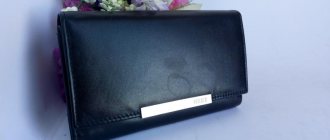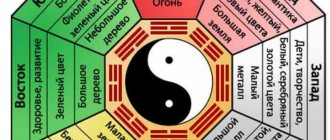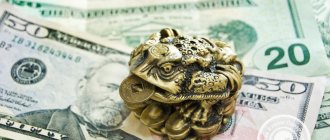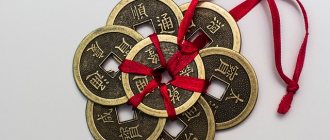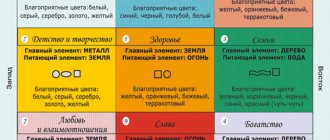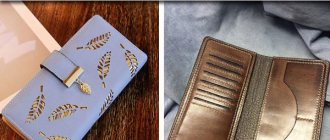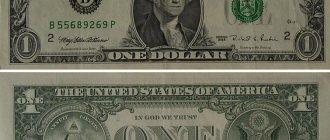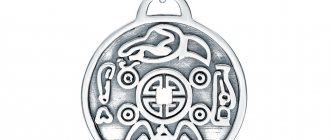Recently, in a sincere conversation in the kitchen over a cup of tea, a neighbor admitted to me:
I've been making ends meet for years now... Money is slipping through my fingers.
I look at others and envy them, because they have renovated their apartment, bought a new car, and fly on vacation 3-4 times a year...”
If you are also wondering why you get money through sweat and blood, while it seems to stick to others, this article is for you!
Get a step-by-step system for attracting money based on the universal laws Get a step-by-step system for attracting money based on the universal laws of attraction!
You will learn how to program yourself to wealth and increase your income with the power of thought >>>
And in this article I will share with you one not very common, but very effective way to attract money. This is the most ancient method, which is used along with meditative techniques.
Can you guess what we're talking about?
Let's talk about the language of symbols of wealth and prosperity.
The symbol of money is an energetic key that opens the door behind which material wealth is hidden. Our ancestors used these keys. They passed on knowledge from generation to generation and literally imprinted magical symbols in the collective memory, which we will talk about later.
Every person on earth, raised in society, in one way or another uses the language of symbols to attract material wealth. However, most often this happens at the level of cultural traditions and superstitions.
Figurines of eastern gods, coins, talismans, money frogs and other symbols can be found in almost every home. But money symbols are often used incorrectly. Therefore they don't work.
How to learn to understand the language of symbols and make magical signs attract real wealth?
Andrey Levshinov talks about this in detail in his work “Book for Multiplying Money.”
Who is Andrey Levshinov
Andrey Levshinov is a Doctor of Psychological and Philosophical Sciences, laureate of the National Greatness Prize, author of numerous works on psychology, yoga, oriental medicine, healthy lifestyle and transformation of consciousness.
He spent 8 years traveling, immersing himself in Eastern culture. He studied Buddhist psychopractices from great masters, studied yoga practices, and practiced karate and other martial arts.
Levshinov “packed” the accumulated knowledge into a system of spiritual and physical development understandable to the Russian reader. The system teaches that the laws of the Universe and meditative practices are the key to health, love, success and wealth.
Middle Ages. Undershirt
Even in ancient times, people realized that walking without underwear was inconvenient, and began to wear shirts made of thin materials under their clothes - for example, in Ancient Egypt they wore linen shirts, and in Greece they wore chitons made of flax or wool.
Later, in the Middle Ages, knights began to wear linen shirts under their armor, and for people from the upper class, tailors made thin shirts from cotton or linen. And only especially rich and privileged people could order themselves a silk shirt - this was considered an expensive pleasure: as a rule, the same shirt was worn for many years, and then passed on to relatives by inheritance - there was even a special clause in the will for this item of clothing.
At the same time, younger relatives often received shirts in a completely unsightly form: in the Middle Ages it was not customary to wash and wash them often, and stains appeared on clothes that were worn day after day on dirty bodies that were difficult to remove.
In the 16th century, when it was fashionable for women to wear dresses with a V-neck, shirts were made so that they could be seen through this neckline - so a lady could show that she was wealthy enough to wear underwear (about the same in the 21st century). century, many began to wear jeans pulled down so that an elastic band with the brand name peeks out from under them).
It is known for certain that in 1520 one of the residents of Koenigsberg inherited as many as three undershirts and boasted to her neighbors for a long time - even for wealthy people, having at least one undershirt was already a sign of chic and refined taste.
Later, already during the Renaissance, the shirt gradually turned from a luxury item into a generally accepted item of clothing. Not only the collar began to peek out from under the outerwear, but special slits began to be made on the sleeves of dresses so that the fabric of the shirt could be pulled through them.
True, those parts of the shirts that looked out quickly got dirty, and there were no bleaching agents then. Therefore, only noble people bought light silk shirts for themselves, and commoners wore shirts made of coarse fabric of dark colors, on which dirt was not so noticeable.
The energy of money: three laws of the Universe that you need to know and follow
What is money in its essence?
Everything we see around us - people, animals, plants, stones, rivers, clouds - is nothing more than material manifestations of energy. And money is no exception, it is a type of universal qi energy; coins, bills, jewelry are its visible embodiment.
Money is energy. Clean and neutral. It acquires color only when we begin to use it.
While the rich get richer, the poor get poorer...
Considering money to be something evil and bad, and the desire for it to be low, a person turns the energy of money into a negative direction, thereby bringing adversity upon himself. An imbalance of energy leads to the destruction of well-being, health and other areas of life.
Money can denigrate the soul of a person who has put it above all else in the world and seeks it at any cost. But they can also enrich it, help to do good, reveal and realize their abilities, make the world around them better.
Therefore, before you begin to study the language of symbols to attract wealth, it is important to know the laws of the Universe that govern the energy of money.
Law 1. “The energy of money is obedient to attention”
What kind of energy (abundance or need) you charge your life depends on your thoughts, focus and concentration.
Money loves attention. There is no need to be shy or afraid of them. Dream, think about wealth as often as possible. Focus on the energy of money, open your heart to abundance.
It is the wrong attitude towards money that gives rise to greed, theft, poverty and poverty, full of problems, a joyless existence.
Law 2. “Any message invariably comes back”
Like attracts like. Love attracts love. Hatred attracts anger and enmity. And the fear of big money attracts poverty. This is how the Universe protects a person from unnecessary worries. No money - no fears.
But when you are open to money, focused on its energy, then your state, like a magnet, attracts abundance in response. To attract money into your life, you need to pay attention to money energy on yourself.
On the subject: How to become rich and get rid of money blocks
Law 3. “You must give (money) in joy in order to receive in joy”
The energy of joy attracts the energy of money.
Therefore, when repaying a debt, paying a loan or utilities, mentally focus on the fact that the money given now will soon return to you in much larger quantities. Share the energy of money without regret.
This is one of the most difficult laws of the Universe to implement. After all, as they say about debt: “You take someone else’s for a short time, but return your own.” And I really don’t want to give away my hard-earned money.
But it is precisely this law that is the path to understanding the management of the energy of money.
Through giving, we deepen our experience of managing the energy of money. Joyful thoughts travel faster than gloomy, despondent ones.
Japan
Maneki-neko is an ancient Japanese talisman for attracting good luck and money, also known as the "Luck Cat", "Luck Cat" or "Money Cat". This sculpture, widespread in the east, mainly in Japan and China, is made of porcelain, paper and wood, depicting a fat cat with its paw raised in an inviting gesture, which lures money, luck and happiness to its owner. Figurines of “Lucky Cats” are usually displayed in a prominent place: in shop windows or at the entrance to a store, temple or office. For a long time it was believed that a cat washes its face in anticipation of the rain. Researchers suggest that the prototype for Maneki-Neko was a Japanese proverb from the 9th century: “if a cat washes its face and ears, it will rain.” In the rain there may be unexpected visitors. This is probably where the superstition arose that if a cat washes itself, expect guests. The color of the Money Cat will depend on what you want to attract into your home. Thus, white Maneki-neko symbolizes luck and good fortune. Black - prevents misfortune and protects from evil. The color gold is good luck in money matters and business prosperity. Pink - attracts love, brings wedding closer and improves relationships. A cat with closed eyes lures “near wealth”, with open eyes - “distant wealth”.
Language of symbols. How do wealth symbols work?
There are many cultures around the world, each with their own symbols of abundance.
The symbol of money is a sign whose semantic code is inscribed in the genetic memory of the people. You may not even believe in its power or know of its existence. But the collective subconscious (the memory of tens and hundreds of generations) has already imprinted the codes of these signs into the subcortex of your brain.
Symbols have phenomenal power. They are able to accumulate and release energy.
By using this or that symbol of wealth, you tune in to receive the energy of money. Like a golden key, it opens the door to a hiding place where your inexhaustible energy resources are hidden.
And here you may think: I have a figurine of Hotei at home.
There is also a frog on coins and a huge money tree. There are many different talismans and amulets. In short, there are a lot of symbols, but zero effect.
Why? On the subject: Money amulet: how to attract wealth and prosperity
You need to understand that methods of attracting wealth are designed for a certain circle of people involved in the culture in which these methods were born.
It's the same with symbols. The language of symbols is an imprint of a particular culture, a reservoir of collective experience. And if you have nothing in common with the culture of China, then even if you decorate your whole house with Feng Shui symbols, it still won’t make you any more money.
For a money symbol from another culture to work, you need to be imbued with the spirit of the people who created this sign. And for this you need to go to another country, live and experience its culture, study history and traditions, and learn from experience.
Another thing is the Slavic symbols of abundance. They are the ones imprinted in our subconscious and should work by default, says Andrey Levshinov.
Slavic symbols of wealth are runes and signs of the ancient gods. These symbols are written in the energy information field of hundreds of generations of Slavs. And you have a family connection with them.
But no amount of runes, spells or meditations will help if you don’t get rid of it >>>
Clover
The four-leaf clover leaf is a symbol of good fortune and luck. And among many nations. The ancient Egyptians believed that an amulet in the form of a clover would save you from dark forces, so they put its design on the mirrors so that nothing creepy would come out of the looking glass. Indian tribes considered the quatrefoil the patron saint of hunting and agriculture. Indians and Slavs, Buddhists and Christians believed in its magical functions.
It is believed that accidentally finding such a leaf means great luck or wealth. To improve your financial situation, you should put a talisman in your wallet. If you spend a long time crawling through a lawn seeded with clover, but cannot find a leaf of the desired configuration, replace it with a red clover flower. A dried flower in your wallet should also make you richer. Well, in theory.
10 money mistakes that kill love
Learning to understand the language of symbols: interpretation of runes to attract wealth
Runes are essentially signs of the ancient alphabet. There are many myths and legends associated with them. The runic writing system was used by the peoples of northern Europe and the ancient Slavs.
Runes have strong energy; they are able to influence the inner and outer world of a person. The energy of the rune acts in accordance with your goals. With their help you can attract love, achieve success, solve a problem, etc.
To create a talisman rune for yourself, you can draw it on an object made of natural material (wood, paper, clay, stone).
The following runes will help you in attracting wealth:
Fehu
Denotes wealth and prosperity in all its manifestations. Money, gold, property.
Fehu helps people get out of poverty and get back on their feet. Promotes the acquisition of material wealth. Protects against mistakes associated with the material world.
Dagaz
Meaning: transformation, breakthrough, beginning of the day (new life).
This rune helps to achieve a long-awaited breakthrough in business. Marks a time of success and prosperity.
Perto
Denotes secret, hidden information, return of lost things.
Perto helps to discover sources of unexpected profit, as well as an unexpected return of lost material wealth (money, things, etc.).
Sowilo
Meaning: victory, power, triumph.
A powerful rune, which is a symbol of upcoming victory and success in business. Helps successfully complete projects and resolve difficult situations.
Otala
Meaning: property, acquisition, inheritance.
This rune is used to “build up” property and create a family heritage. Helps attract unexpected money and material benefits.
Practice with runes
Choose a few runes that suit your goals. Take a piece of paper and draw a rune, focusing on your desire. It is better to draw with a green or red felt-tip pen, says Andrei Levshinov, since these colors attract the energy of money.
Draw the rune, carefully drawing out each line, putting maximum attention, desire and inner strength into it.
Every time before going to bed, look at the image of the rune for a few minutes and fall into a dream. Then hide the paper under your pillow and hold the image of the goal in your head until you fall asleep.
Where is the wealth zone in the house?
An ancient teaching says: in order to attract love into the house, you should start arranging the southwestern part of the house, and to advance up the career ladder - its northern part.
Such a vital sector as wealth and material well-being is located in the southeastern part of the house, where the element of wood rules. This sector can be activated using colors and materials that match the ruling element, as well as other decorations that symbolize wealth.
For the interior, you can use any wooden elements and furniture in shades associated with wood - woody, green, and blue-blue colors are also allowed, relating to the element of water that nourishes wood.
Additionally, you can use photo wallpapers, paintings or photographs that display seething energy, growth, movement, for example, depicting a waterfall, stream, reeds, forest grove. Representatives of the woody element – indoor plants – should also be placed in this part of the interior. Crassula or money tree, ficus, lemon bush, palm trees are preferred.
Symbols of Slavic gods are the key to abundance and wealth
The ancient Russians believed in the power of generous gods, who protected the well-being of their children (Slavs) and showered them with gifts.
Dazhdbog
- the god of light and all blessings, both material and spiritual. This is the “wealth-giving” god and it was to him that our ancestors always turned with requests for material help. And even now, when turning to higher powers, people often say: “God willing,” unconsciously turning their request to the ancient patron of the Russians.
Veles
- brother of Dazhdbog, master of three worlds, giver of good luck and wealth, god of the family economy, patron of merchants and sages.
Veles and Dazhdbog are the favorites of the Slavic peoples. Therefore they
symbols have accumulated the energy of generations for dozens of centuries.
Our ancestors “prayed” these signs, like icons in churches, due to which they have powerful power.
Work with the symbols of the gods in the same way as with runes. You need to focus on your desires related to money.
It's better to focus on the end result. For example, if you need money for a car, then imagine yourself driving this car. Then select the symbol of Veles or Dazhdbog.
Draw an image of a symbol on a piece of paper, putting the power of a dream into the drawing. And look at the symbol every time before going to bed, mentally making a request to God.
It is important to understand that the runes and symbols themselves are just drawings. The energy you put into their image can “revive” them.
You can also use the language of symbols (signs of runes and gods) to enhance meditations, affirmations and other practices. With each exercise, the energy of the symbols will grow, and along with it your “money magnetism” will increase.
Get the “Complete Guide to Attracting Big Money into Your Life.”
You will learn the main mistakes in handling money and receive 10 powerful affirmations and 3 meditations to attract any amount into your life.
Get your guide for free! >>>
An effective talisman for good luck: buy or make it yourself?
What personal happiness is, everyone decides for himself: there are no universal formulas here. Therefore, it is better to make amulets of happiness yourself or accept them as gifts from sincerely loving people.
The most universal and effective are:
- Burdock of Happiness. This is one of the most famous Slavic amulets, which visually represents a rhombus with square teeth. The meaning of the Burdock of Happiness amulet is surprisingly multifaceted: it gives good luck, financial well-being, respect from others and the best human qualities.
- Talisman "Knot of Happiness". There are many known lucky knots, but the most effective of them is the Tibetan infinity symbol Srivatsa. It can be made from wire or simply drawn and hung on the wall.
- Amulet Lucky. In the classic version, Lucky is a handmade soft doll in the Russian style. It is sewn from colored scraps, stuffed with cotton wool, and decorated with beads, coins, and braid. A mandatory element is a long light brown braid.
Silver pendant with onyx “Burdock of Happiness” (go to the SUNLIGHT catalogue)
Any trinket can be imbued with cosmic energy and attract happiness to its owner exactly in the format as he sees it. To do this, it is enough to believe in the power of the amulet, hold the talisman in your hands more often and turn to it with clearly formulated requests.
Language of Symbols. 3 conditions for raising money
For proper circulation of money energy, it is important that your energy channels are tuned to it.
But negative attitudes regarding money block energy channels and do not allow cash flows to fill your life.
Do you think money is evil? That rich people are liars and criminals? Or are you sure that money should come only through pain and calluses?
Such attitudes block the flow of energy of abundance.
Imagine that your life is a safe and you have a lot of cash in your hands. You open the door, and everything is filled with rubbish: trinkets, old newspapers with headlines about the crisis, boxes of matches and a bag of buckwheat “for a rainy day,” a handful of Soviet coins. The safe is full, but there is no room left for money.
Junk is your negative attitudes. By getting rid of them, you will gradually make room in your life for the energy of money.
On the subject: Negative attitudes: how to identify everything at once and remove it forever?
Therefore, the first condition for attracting money
is to get rid of incorrect attitudes.
The 2nd condition
is to adjust the body at the energy level
in order to become a magnet for material wealth.
Yoga asanas are also symbols that we create using a certain position of the body in space. Each asana cleanses and strengthens one or another chakra, opens the body to accept various energies, etc.
Andrey Levshinov explains exactly how to work with energy channels and chakras in his work “Book for Multiplying Money,” as well as in books on the topic of yoga.
The 3rd condition is to believe.
Skepticism and negative thinking block the mind, preventing it from opening to new experiences.
This way you protect yourself from encountering the wonders of the Universe. Faith is the key to all energies of the Universe.
Making glyphs for abundance with your own hands
You don’t have to be a master to make runes for enrichment yourself. Interestingly, hand-made signs are much stronger than ordinary ones. When creating, a person transfers part of his energy to objects.
The most popular resources for creating manually:
- paper;
- tree;
- leather;
- pebbles;
- metal;
- textile.
It is worth choosing the color for the coating in advance and making a reservation. The created amulet can be carried with you. In this case, it acts for a long time.
Bonus: Andrey Levshinov’s practice “How to become a magnet for money”
Pick up an item that is associated with wealth, for example, a high-denomination bill, a gold ring, a bank card (your own symbol of money).
Focus mentally on this object, and then imagine that your biofield is opening up like a wallet. It gradually pulls the object into itself.
You and this attribute of wealth are now one. There is a powerful connection between you.
Now imagine an object inside your biofield. He is shrouded in a golden glow. Take a deep breath and imagine that you are drawing in this golden glow and it is accumulating in the area between your eyebrows. Now, along with your exhalation, lower this clot of light to the center of your chest. Visualize the golden energy of money accumulating in your chest.
Breathe steadily, focusing on the energy in your chest for a few more minutes until you feel a slight tingling, coolness, or “blowing” in the area.
Repeat as often as possible. This exercise will allow you to better understand the language of symbols and open the energy of money into your life.
What items do you use to attract money into your life? Do you believe in symbolic language?
Rune Fehu
Rune Fehu, aka Feu, aka Fe, is the first rune of the elder, junior and Anglo-Saxon futhark (runic alphabet). Literally it is translated as “cattle” (from the German vieh) or as “payment, material wealth” (from the English fee). The meanings, which seem so different at first glance, are actually not so different. In the ancient world, livestock as movable property was considered a measure of wealth and served as a means of payment until this function was transferred to money.
The Fehu rune is considered the most powerful rune for attracting and saving money. For this purpose, the symbol is drawn, carved or engraved on jewelry. Fehu can also be applied to a banknote, wallet, candles, clothes and even to your own body.
XVII-XVIII century. Rattan cane
In the 17th-18th centuries, only aristocrats and wealthy people could afford a cane. Later, around the 18th century, the cane became a common fashion statement that anyone could buy.
The main part of the cane was the handle - it was made of gold, silver, porcelain or ivory. For those who could afford such a luxury item, there were certain rules: for example, it was considered a sign of good taste to wear different canes during the day and evening. During the day we walked with a rattan cane - it had a strong brown shaft. In the evening or on special occasions, it was customary to carry canes made of hard wood with ebony trim.
Canes were most popular in England - gradually it became considered indecent for a nobleman to appear on the street without a cane, and for a young man from a noble family, buying a cane was something of an initiation. If a young man appeared at a social reception with a cane, he automatically ceased to be considered a teenager and from that moment on was already an adult, a groom.
However, this accessory was in fashion not only among men: in the 30s of the 17th century, small elegant canes for ladies began to appear in France. Some believe that this was due to the fashion for high heels - sometimes it was uncomfortable to walk in them without support.
When canes first came into fashion in the 17th century, they were made to be approximately half the height of a person, but by the beginning of the Great French Revolution they became half as long and lost their practical significance, because now they could not be leaned on. So gradually they began to carry the cane under the arm, so that on occasion they could take it out and gracefully twirl it in their hands, demonstrating their high status.
XIX-XX century. Neckerchief
In the 18th century, the first dandies appeared in England - fashionable men with aristocratic manners, people from the middle class who carefully looked after themselves. One of the main dandies was the “Prime Minister of Elegance” George Brummel, the son of an influential official with an excellent education. It was he who introduced the fashion for a men's suit with a tie and a white shirt. Contemporaries often called him “handsome Brummel.”
It was thanks to him that tying neckerchiefs in the era of dandyism became a real art - first he tied his light scarf from thin muslin, lowering the wide end to the chest, then passed the narrow ends behind his back and brought them to the neck. Next, it was necessary to quickly tie a knot using a certain technology. Sometimes he would stand in front of the mirror for hours, tying scarves over and over again (after an unsuccessful attempt, he would take a new one) until the result seemed perfect to him.
The more people adopted dandy fashion, the more subtleties real dandies invented to recognize each other. After all, true dandyism is not only beautiful clothes, but also a special civic position. With the help of outfits, dandies protested against the bourgeois “equalization” and dullness.
Every subtlety was important to identify each other. For example, for a real dandy, it was not enough to simply tie a scarf around the neck with the right knot - it had to have seemingly careless folds, which were actually carefully thought out. Brummel spent a lot of time folding his scarf in a deliberately careless and at the same time beautiful manner.
Over time, he even came up with the idea of using starch for this, although for a long time he did not tell anyone about it. Later, when he left England, a note was found in his boudoir with one single word: “Starch.” So he passed on his secret to the next generations of dandies.



